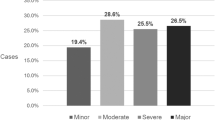Abstract
Background:
The incidence of hand infections caused by penetrating fish fins or bones injuries (FFBI) is likely to increase following worldwide constant growth of fishery production and consumption. Because data on these infections are scarce, the purposes of this study were to describe their clinical characteristics and disease course, and to analyze risk factors for a complicated disease course.
Methods:
We studied retrospectively all cases of hospitalized patients with hand infections following FFBI over the years 1999–2006 in a single medical center. Demographic data, underlying diseases, clinical characteristics and disease course were analyzed for each case. Univariate and multivariate analysis were used for analyzing risk factors for a complicated hospitalization course.
Results:
There were 122 separate episodes of hand infections following FFBI among 116 patients, with a mean age (± SD) of 52 ± 19.7. The majority of cases were women (51.6%), and they arrived significantly later to the hospital after injury. Predisposing conditions (diabetes mellitus, liver disease, rheumatologic disorder, malignancy or chronic steroid treatment) were present in 25% of cases. Most of the cases presented with cellulitis. Cultures of either blood or wound were obtained in ∼1/3 of cases, and 40% of them yielded an isolate. Ceftazidime and doxycycline were administered to 68.8% and 96.7% of cases, respectively. Surgical debridement was performed in 34.4% of cases, but there was no case of death or limb amputation. The presence of fever (p = 0.0005) and a predisposing condition (p = 0.035) were independently correlated with a complicated hospitalization course.
Conclusions:
The overall prognosis in this largest cohort of hand infections following FFBI was favorable, but immune dysfunction carried a complicated course.
Similar content being viewed by others
References
Vincent JL: Nosocomial infections in adult intensive care units. Lancet 2003; 361: 2068–2077.
Pittet D, Tarara D, Wenzel RP: Nosocomial bloodstream infection in critically ill patients. Excess length of stay, extra costs and attributable mortality (comment). JAMA 1994; 271: 1598–1601.
Schwartz B, Bell DM, Hughes JM: Preventing the emergence of antimicrobial resistance. A call for action by clinicians, public health officials, and patients. JAMA 1997; 278: 944–945.
Kollef MH, Fraser VJ: Antibiotic resistance in the intensive care unit. Ann Intern Med 2001; 134: 298–314.
American College of Chest Physicians/Society of Critical Care Medicine Consensus Conference Definitions for sepsis and organ failure and guidelines for the use of innovative therapies in sepsis. Crit Care Med 1992; 20: 864–874.
Clinical, Laboratory Standard Institute: Performance standards for antimicrobial susceptibility testing. Nineth-fifteenth informational supplement. CLSI, Wayne, PA, pp 1999–2005.
WHO Collaborating Centre for Drug Statistics Methodology: ATC/DDD index. http://www.whocc.no/atcddd
Ramsay C, Brown E, Hartman G, Davey P: Room for improvement: a systematic review of the quality of evaluations of interventions to improve hospital antibiotic prescribing. J Antimicrob Chemother 2003; 52: 764–771.
Ansari F, Gray K, Nathwani D, Phillips G, Ogston S, Ramsay C, Davey P: Outcomes of an intervention to improve hospital antibiotic prescribing: interrupted time series with segmented regression analysis. J Antimicrob Chemother 2003; 52: 842–848.
Wagner AK, Soumerai SB, Zhang F, Ross-Degnan D: Segmented regression analysis of interrupted time series studies in medication use research. J Clin Pharm Ther 2002; 27: 299–309.
National Nosocomial Infections Surveillance System National nosocomial infections surveillance (NNIS) system report. Data summary from January 1992 through June 2004. Am J Infect Control 2004; 32: 470–485.
Pfaller MA, Jones RN, Doern GV, Kugler K: Bacterial pathogens isolated from patients with bloodstream infection: frequencies of occurrence and antimicrobial susceptibility patterns from the SENTRY antimicrobial surveillance program (United States and Canada, 1997). Antimicrob Agents Chemother 1998; 42: 1762–1770.
MacDougall C, Polk RE: Antimicrobial stewardship programs in health care systems. Clin Microbiol Rev 2005; 18: 638–656.
Geissler A, Gerbeaux P, Granier I, Blanc P, Facon K, Durand-Gasselin J: Rational use of antibiotics in the intensive care unit: impact on microbial resistance and costs. Intensive Care Med 2003; 29: 49–54.
Meyer E, Buttler J, Schneider C, Strehl E, Schroeren-Boersch B, Gastmeier P, Ruden H, Zentner J, Daschner FD, Schwab F: Modified guidelines impact on antibiotic use and costs: duration of treatment for pneumonia in a neurosurgical ICU is reduced. J Antimicrob Chemother 2007; 59: 1148–1154.
Burke JP: Antibiotic resistance - squeezing the balloon? JAMA 1998; 280: 1270–1271.
Loeffler JM, Garbino J, Lew D, Harbarth S, Rohner P: Antibiotic consumption, bacterial resistance and their correlation in a Swiss university hospital and its adult intensive care units. Scand J Infect Dis 2003; 35: 843–850.
Meyer E, Schwab F, Jonas D, Rueden H, Gastmeier P, Daschner FD: Surveillance of antimicrobial use and antimicrobial resistance in intensive careunits (SARI): 1. Antimicrobialuse in German intensive care units. Intensive Care Med 2004; 30: 1089–1096.
de With K, Steib-Bauert M, Straach P, Kern WV: Is there significant regional variation in hospital antibiotic consumption in Germany? Infection 2006; 34: 274–277.
de With K, Meyer E, Steib-Bauert M, Schwab F, Daschner FD, Kern WV: Antibiotic use in two cohorts of German intensive care units. J Hosp Infect 2006; 64: 231–237.
Bantar C, Sartori B, Vesco E, Heft C, Saul M, Salamone F, Oliva ME: A hospitalwide intervention program to optimize the quality of antibiotic use: impact on prescribing practice, antibiotic consumption, cost savings, and bacterial resistance. Clin Infect Dis 2003; 37: 180–186.
Esposito S, Leone S: Antimicrobial treatment for intensive care unit (ICU) infections including the role of the infectious disease specialist. Int J Antimicrob Agents 2007; 29: 494–500.
Author information
Authors and Affiliations
Corresponding author
Rights and permissions
About this article
Cite this article
Imberg, R., Potasman, I., Weissman, Y. et al. Hand Infections Following Penetrating Fish Fins or Bones Injuries (FFBI): A Large, Hospital Based, Retrospective Study. Infection 36, 565–569 (2008). https://doi.org/10.1007/s15010-008-7280-3
Received:
Accepted:
Published:
Issue Date:
DOI: https://doi.org/10.1007/s15010-008-7280-3




